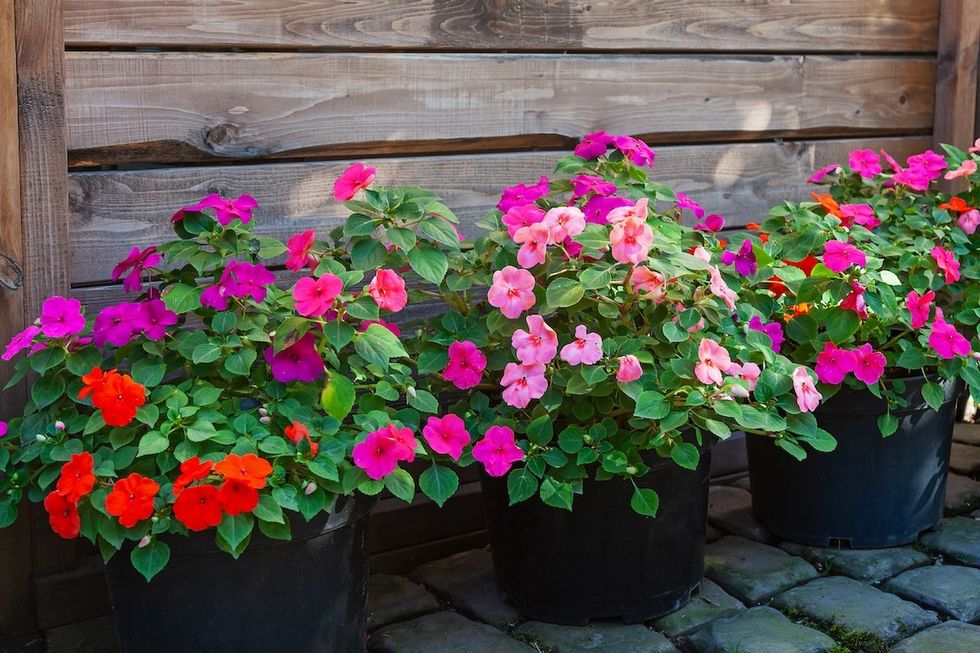Big, beautiful trees in our yards are usually a welcome addition, but the shade they cast can be problematic for growing other plants and flowers. Lawns or patios that face north or east may also be lacking in the sun department. But if you struggle with low natural light on your property, it’s still possible to grow a garden—you just have to select the right plants. To learn what’ll grow best in shady areas, we spoke to plant and gardening experts. Keep reading to get their recommendations for the easiest and most beautiful outdoor plants that don’t need sunlight.
RELATED: 12 Easy Houseplants That Don’t Need Sunlight.
1. Impatiens
Shutterstock
When it comes to colorful flowers, impatiens might be the most popular low-light plant.
“They need very little sunlight to successfully bloom and are fast-filling,” says Rebecca Sears, CMO and resident green thumb at Ferry-Morse. “Impatiens produce vibrant, healthy flowers from summer to fall without much maintenance required, making them a great variety for beginner gardeners still developing their green thumbs.”
You can find this flower in shades of white, red, purple, pink, yellow, and orange, notes Erinn Witz, a garden expert and co-founder of Seeds and Spades. Their vibrant colors make them a wonderful option for a border around a tree or shrubbery, she adds.
2. Hostas

iStock
“Pretty much every gardener has at least a few hostas, and for good reason—they look lush and beautiful, and they’ll grow almost anywhere without much effort,” explains Witz.
Ben Hilton, founder and editor of The Yard and Garden, also recommends this plant for shady gardens and adds that they “prefer moist, well-draining soil and benefit from regular watering.”
Like impatiens, hostas make great border plants and can grow in clusters. Witz prefers the variegated versions (their leaves are a mix of green, white, and yellow) for some added dimension.
RELATED: Gardening Influencer Reveals the #1 Plant to Give Your Yard Beautiful Color.
3. Begonias

Right up there with impatiens, begonias are a colorful staple for low-light flower gardens.
In fact, Elle Meager, a qualified permaculture teacher and the founder and CEO of the website Outdoor Happens, previously told Best Life that these flowers thrive in shade and even do well in the shadows of big trees and shrubs.
“The secret to growing begonias is avoiding overly wet soil and sunlight. Most cultivars I’ve tried react poorly to full sun, so try planting them under your front yard oak tree, alongside a building with afternoon shade, or even in your fully shadowed corner garden,” she explained.
4. Astilbes
Shutterstock
For another pop of color in a shady garden, Hilton suggests astilbes (commonly known as false goat’s beard): “These perennials are renowned for feather-like attractive plumes of pink, white, or red flowers that bloom in mid-summer.”
He recommends them for north-facing or boggy gardens, and notes that they prefer most soil.
5. Ferns

Shutterstock
There are many varieties of ferns, but as Witz notes, “most of them thrive in damp, shaded areas that mimic their natural woodland homes.”
Hilton says some of the best types of ferns for shady yards are maidenhair ferns, sword ferns, and lady ferns. “Use them to fill challenging spaces in corners or under trees,” he adds. They also work well in hanging baskets on the porch.
RELATED: 9 Plants That Will Keep Mosquitoes Out of Your Yard, According to Pest Experts.
6. Sweet potato vine
Shutterstock
Contrary to its name, this plant does not produce sweet potatoes, but instead grows in long, trailing vines in hues from yellow-green to dark purple-red.
Sears shares that sweet potato vine grows well in partially shaded areas and that you have quite a bit of flexibility with where you plant it: “Its vines look great in hanging baskets, window boxes, or growing up a trellised wall.”
This plant also loves the heat and is drought-tolerant, so it’s very beginner-friendly.
7. Lungwort
Shutterstock
Pulmonaria, also known as lungwort, grows naturally in the moist, shady environment of forest floors, explains Hilton, so they’re adaptable to a low-light garden.
“They produce delicate, bell-shaped flowers that can add a splash of color to a shady spot, and they have attractive, spotted foliage that can add interest to a shady garden even when they are not in bloom,” he says.
8. Bee balm
Shutterstock
Yes, bee balm attracts bees—and hummingbirds and butterflies!—which is a good thing, as it will help pollinate your entire garden throughout the season.
Bee balm is also a vibrant perennial that will “bloom in partial shade and moist soil,” says Sears. She points out that these look lovely in bouquets when cut.
RELATED: 7 Plants You Can Buy That Are Actually Dangerous Invasive Species.
9. Bleeding hearts

For something truly unique, bleeding hearts are a shade-loving perennial that does well in low-light settings provided they have moist, well-draining soil, says Hilton.
Witz explains that bleeding hearts are native to shaded woodland environments, so “they thrive in those sheltered areas where many other flowers wither away.”
They’re so named for their heart-shaped flowers that bloom in spring and come in shades of pink or white.
10. Snowdrop

Technically known as Galanthus, this unique flower is so nicknamed because its white petals droop down.
Snowdrop is the only plant on this list that’s a bulb, meaning you plant it in the fall, allow it to mature over the winter, and watch it come to life in the spring.
“Thriving in cooler climates, this resilient and charming choice prefers partial to full shade and well-drained soil,” Gene Caballero, co-founder of YourGreenPal, previously told Best Life. “This delicate white flower can often push through the last remnants of snow, symbolizing the onset of spring.”
Content shared from bestlifeonline.com.





